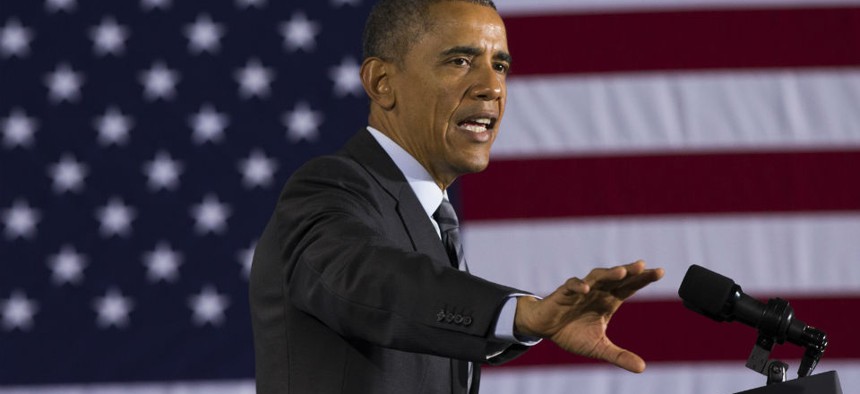Obama's Budget Offers 'Smart' Spending Cuts to Pay for Management Initiatives, End to Sequestration
Cuts will free up funds for customer service improvements and cross-agency management goals.
President Obama’s $4 trillion fiscal 2016 budget would rely on new revenues and “smart spending cuts” to continue the administration’s investments in its second-term management agenda and to help pay for an end to sequestration and a $38 billion boost in defense spending, while lowering the deficit.
Newly released budget documents and statements Monday from White House officials showcase plans for a continued push to improve customer service, fulfill cross-agency priority goals, consolidate “redundant” agencies to better serve economic growth and rely more on “evidence-based” program evaluation.
“The budget includes initiatives to improve the service we provide to the American public,” Obama said in a statement, “to leverage the federal government’s buying power to bring more value and efficiency to how we use taxpayer dollars; to open government data and research to the private sector to drive innovation and economic growth; to promote smarter information technology; and, to attract and retain the best talent in the federal workforce.”
Supporting a “government of the future” means acknowledging Americans’ increasing expectation for customer service via technology, said Beth Cobert, deputy budget director for management, during a conference call with reporters. Hence the budget includes a proposed $105 million to scale up and institutionalize digital teams under the new U.S. Digital Service.
The budget allocates $450 million to “drive forward progress on cross-agency management priorities,” and it proposes authority for agencies, with prior notification to the Congress from the director of the Office of Management and Budget, to transfer up to $15 million from their individual budgets to support cross-cutting management initiatives.
In addition, the budget proposes $200 million for the General Services Administration to carry out office space consolidations, further reducing the federal government’s real estate footprint. The White House also repeated a past $57 million proposal to implement the proposed Civilian Property Realignment Act. If it cleared Congress, this proposal would set up an independent board to recommend lists of unneeded federal properties to sell off, generating an estimated $1.2 billion in proceeds.
The budget announced a new expansion of the administration’s benchmarking program, to include customer satisfaction metrics and to make the results part of agency performance reviews and strategic planning exercises. In addition, it would “take to scale” various “evidence-based approaches” to applying behavioral sciences to programs ranging from reducing veterans homelessness to college completion to fine-tuning international development.
“One major focus of the budget is increasing availability of data that the government already collects through administering programs—also known as ‘administrative data’—to answer important questions about the effectiveness of federal programs and policies,” the budget documents said. That includes improving public access to federal data sets in such areas as unemployment insurance while protecting privacy.
The budget also proposes to fund “idea labs” -- already in play at the Health and Human Services, Commerce, Education and Treasury departments, as well as at GSA and the Small Business Administration -- to recognize forward-looking employees and drive “a culture of innovation that yields results.”
And it includes “an ambitious plan for Senior Executive Service reform,” it stated.
The budget repeats Obama’s 2012 proposal to consolidate six “redundant” agencies into a new business and trade department, though Cobert on Monday told reporters that any estimates of savings would not emerge until Congress processes the request.
The budget also offers continuing reforms to “program integrity” efforts—implementation of two key laws dealing with reducing improper payments to unqualified beneficiaries, through which the administration hopes to save $110 billion through 2025.
To pay for new spending on management and still reduce the deficit—as well as pay for ambitious initiatives in defense, child care, education and infrastructure—the budget includes a combination of tax hikes targeted at corporations and the wealthy along with spending cuts and consolidations. It identifies 101 such discretionary program cuts projected to save $14 billion in 2016.
During a Monday White House press briefing, top budget officials stressed that the current budget deficit of $468 billion is now at 3.4 percent of gross domestic product, down from the 3.7 percent projected last March. It is expected to fall below 3 percent later this year. “We’re on the heels of a breakthrough year in America,” Budget Director Shaun Donovan said. “We’re paying for all this investment, ending sequestration and [providing] $1.8 trillion in reductions though smart spending cuts.”
Investment in the management agenda will pay off, Jitinder Kohli, director and government performance leader with Deloitte Consulting, told Government Executive. Underlining the proposed $15 million that could be reallocated for cross-agency priority goals, he said, “It will help agencies work together -- rather than in silos -- to address crucial issues such as improved customer service.”
NEXT STORY: Why Women Are Wired for Governance




